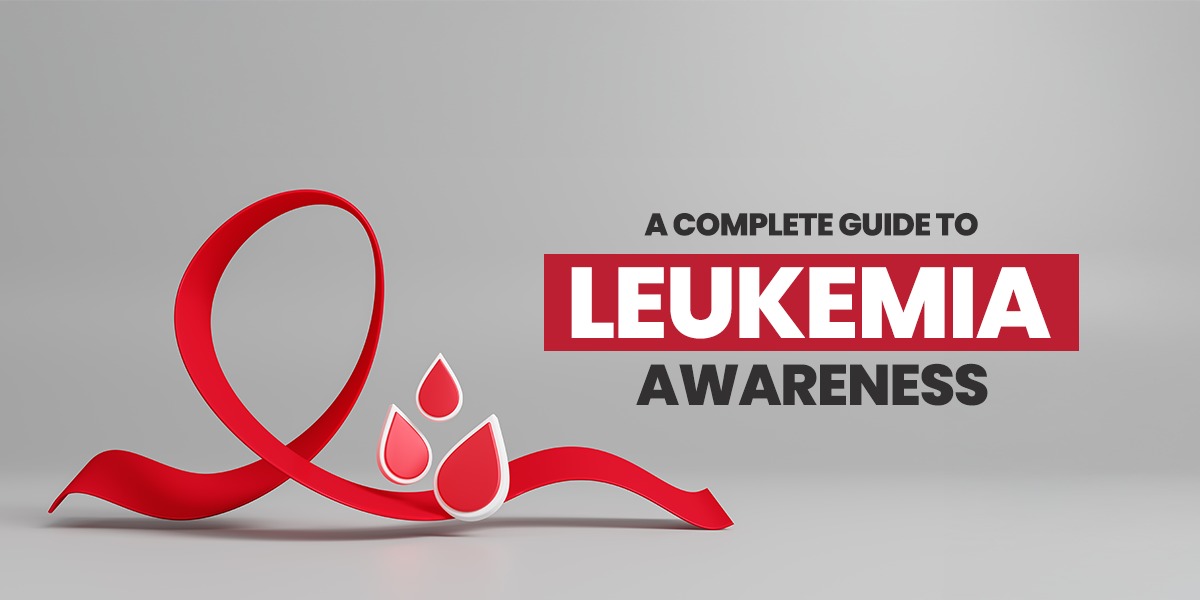Leukemia: Symptoms, Signs, Causes & Treatment

Leukemia is a type of cancer that affects the blood and bone marrow, which is a tissue responsible for producing blood cells. Leukemia starts in the cells of the bone marrow and spreads into the bloodstream. It disrupts the production and function of healthy blood cells. It can develop slowly or progress slowly over time, depending on the type.
Here, we’ll understand what is leukemia, its signs and symptoms, its causes and risk factors, diagnosis, and treatment options.
What is Leukemia?
Leukemia is a cancer of the body’s blood-forming tissues, including the lymphatic system and the bone marrow. This disease involves the overproduction of abnormal white blood cells. These cells play a crucial role in fighting infections. However, in leukemia, these cells are dysfunctional and multiply uncontrollably, which displaces the healthy blood cells. There are four main types of leukemia:
- Acute Myeloid Leukemia (AML)
- Acute Lymphocytic Leukemia (ALL)
- Chronic Myeloid Leukemia (CML)
- Chronic Lymphocytic Leukemia (CLL)
Signs and Symptoms of Leukemia
Signs and symptoms of leukemia can differ depending on its type and stage. Here are the common leukemia symptoms:
Fatigue and Weakness
Because of a shortage of healthy red blood cells, individuals may usually feel tired, even with adequate sleep.
Frequent Infections
Here, the body’s ability to fight the infection is compromised. This can lead to frequent infections.
Fewer and Night Sweats
Recurring fevers and excessive sweating at night are classic warning signs.
Easy Bruising and Bleeding
Reduced platelet count can lead to frequent nosebleeds, bleeding gums, small red spots under the skin, or prolonged bleeding for minor injuries.
Joint Pain
Pain or tenderness, particularly in the arms and legs, may occur due to overcrowded bone marrow.
Swollen Lymph Nodes
Painless swelling in the neck, armpits, or groin.
Weight Loss and Appetite Loss
Many patients experience unexplained weight loss and reduced appetite.
Shortness of Breath and Pale Skin
Reduced red blood cells can cause shortness of breath and a pale complexion.
Causes and Risk Factors of Leukemia
The exact reasons behind this disease aren’t fully known, but some factors can increase the chances of developing it. Here are a few common leukemia causes:
Genetic Disorders
People born with conditions like Down Syndrome and other inherited syndromes are at risk of developing leukemia.
Family History
People with a family history of leukemia are more likely to get it. However, most cases are not hereditary.
Previous Cancer Treatment
Radiation therapy or chemotherapy, used to treat other cancers, can damage bone marrow cells. This can raise the risk of leukemia later.
Exposure to Toxic Chemicals or Radiation
Exposure to heavy industrial chemicals or high levels of radiation also increases the risk of this disease.
Smoking
People who smoke or are around secondhand smoke are more likely to get leukemia.
Age and Gender
Certain types of leukemia are more common in specific age groups. For example, Acute lymphocytic leukemia (ALL) is more frequent in children. Chronic lymphocytic leukemia (CLL) mostly affects older adults. Also, men are slightly more likely to develop it than women.
Diagnosis
A healthcare provider may start with a physical exam, review the symptoms, and perform tests such as:
- Complete Blood Count: This test reveals abnormal levels of white blood cells, red blood cells, or platelets.
- Bone Marrow Biopsy: A sample of bone marrow is usually taken from the hip and is examined for leukemia.
- Genetic and Modular Testing: This test identifies specific mutations that help classify the type of leukemia and guide treatment.
- Imaging Testing: Tests like CT scans, X-rays, or MRI can detect enlarged lymph nodes, spleen, or other organ involvement.
Treatment Options
Leukemia treatment varies depending on its type, progression, patient’s age, and overall health. Some of the common treatments include:
- Chemotherapy: The most common treatment, it uses drugs to destroy or stop the growth of cancerous cells.
- Radiation Therapy: This therapy uses high-energy rays to target leukemia cells. This is used especially in the localised areas or to prepare for a stem cell transplant.
- Targeted Therapy: These drugs attack specific proteins or genetic mutations found in leukemia cells.
- Immuno Therapy: This therapy helps boost or redirect the immune system to fight leukemia.
- Stem Cell Transplant: This replaces diseased bone marrow with healthy stem cells.
- Supportive Care: This includes using antibiotics, blood transfusions, and other medications to manage symptoms and reduce complications during treatment.
Conclusion
Leukemia is a complex and life-threatening cancer. However, recognising symptoms early and seeking prompt medical care can make a difference. With ongoing research and evolving therapies, we must hope for better results in the future.
If you or someone you know is worried and wants to get examined, visit the best cancer hospital in Kanpur, Regency Healthcare.
Also Read: Cancer: Symptoms, Causes, Types, Stages, Treatment & Prevention

 Call-an-Ambulance
Call-an-Ambulance



